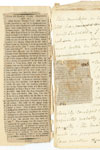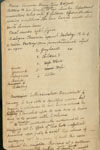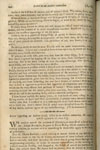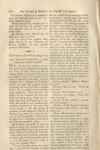Wieland Focus
Wieland; or, The Transformation. An American Tale. By Charles Brockden Brown. (New York, 1798). Wieland’s mystic father prays ardently in the summer house he built near his mansion overlooking the Schuylkill. But when he disobeys an unnamed heavenly command, he spontaneously combusts. His son turns the place into a neo-classical Temple of Reason, and there gets another divine decree – to sacrifice his family. In a new nation where sometimes the voice of the people is misperceived as the voice of God, this Americanized version of the Bible’s Abraham has a new twist: Was that God speaking, or that suspicious ventriloquist lurking around the neighborhood? At the crucial moment, the voice stays Wieland from slaying his sister Clara, who survives to tell the tale. Still in print today, her supremely creepy narrative dominated American Gothic for half a century. It might still make a good Tim Burton musical in the vein of Sweeney Todd.
Left: James Sharples. Charles Brockden Brown. Pastel on paper. (Philadelphia, ca. 1796). Loaned by Pamela Sinkler Todd. English-born Sharples limned most of the important men of the new nation in its capital after he arrived here in 1793. Many of his pastels hung in Peale’s Museum, then on the upper floor of Independence Hall. Never before exhibited publicly, this Sharples, almost surely a youthful Brockden Brown, has been handed down to his now-closest descendant and literary executrix. Permission for use can be obtained from Pamela Sinkler Todd through The Library Company
_______________________________________________________________________________________
C.B.B. [i.e., Charles Brockden Brown.] Advertisement. September 3, 1798. Prefatory to most copies of Wieland; or, The Transformation (New-York, 1798). Since writing fiction was a new and suspect undertaking as opposed to other “useful” writing, early American novelists argued the authenticity of their stories, and their practicality for a new nation. Brown’s Wieland was prefaced by this advertisement reminding casual readers that Carwin’s ventriloquism and Wieland pere’s spontaneous combustion were real, scientifically explained facts; and his son’s extravagant delusions were similar to cases attested by the best physicians. |
|
Charles Brockden Brown. Wieland; or, The Transformation. (New-York, 1798). Collection of Dr. Neil K. Fitzgerald. Brown was not a careful craftsman. Wieland contains hardly anything but declarative sentences; and bibliographical analysis of the first edition indicates the author was still trying to figure out an ending after he started sending copy to the printer. This copy was once in the collection of Philadelphian A. Edward Newton, perhaps the single most prominent popular promoter of book-collecting in U.S. history. Newton had a knack for choosing subtle association copies. The original owner of this one was a minister named Edward Waylen – an identical spelling variant Brown considered for the title character’s name. |
|
Charles Brockden Brown. Wieland, An American Tale. (London, 1822). Collection of Dr. Neil K. Fitzgerald. By the end of the 1820s Wieland had gone through as many foreign editions as American ones. In England, most readers found the novel in this “triple-decker” format. This is how the book looked when Mary Shelley read it, and in the passage displayed she found the germ of her Frankenstein –which was rather incestuous, since her father was William Godwin, whose novels had inspired Brown’s. |
|
“An Account of a Murder Committed by Mr. J---- Y----, upon His Family, in December, A.D. 1781.” In New-York Weekly Magazine. (New-York, July 20, 1796). In 1781, upstate New York farmer James Yates overcame “natural feelings” to fulfill a divine command to murder his family (first literally throwing his Bible into the fire!). The case was one of the models (along with the Biblical Abraham) for Wieland. Brown was only ten years old when the Yates murders were first reported in the press, but he was sure to have read this magazine account that appeared fifteen years later just before he began work on Wieland. |
|
John Marsh. The Great Sin and Danger of Striving With God. A Sermon preached at Wethersfield, December 13th, 1782. At the funeral of Mrs. Lydia Beadle, wife of the late William Beadle, and their four children, who were all murdered by his own hands on the morning of the 11th instant. (Hartford, [1783]). |
|
[Judge Stephen Mix Mitchell]. A Narrative of the Life of William Beadle, of Wethersfield. … The particulars of the “horrid massacre” of himself and family. (Hartford, [1783]). The Yates murders were long thought to be the main source for Wieland, but decades ago, while he was in graduate school, guest curator Dr. Fitzgerald discovered several other similar cases known to Brown, such as this Wethersfield, Connecticut, parricide almost exactly a year later. The storekeeper William Beadle immersed himself in theological reading and ruminations, and decided he was “a proper Deist” to whom God could communicate directly without benefit of clergy or Bible. One day he perceived a heavenly command to butcher his wife and children. Brown’s best friend Elihu Hubbard Smith was Wethersfield’s doctor in the early 1790s and probably told him about the atrocity. |
|
Benjamin Rush, “Facts & documents on moral Derangement as exemplified chiefly in murder.”Manuscript notebook. (Philadelphia, early 1800s). When Brown said that Wieland’s homicidal delusions were similar to actual cases known to physicians, he was thinking of men like Dr. Benjamin Rush, the so-called “father of American psychiatry.” In this notebook Rush pasted newspaper accounts of brutal murders. At about the same time, a Virginia newspaper columnist found parricides so common in recent years that “Even Wieland himself is no longer the visionary hero of a romance!” |
|
Charles Brockden Brown. Early outline for Wieland. Manuscript notebook. (Philadelphia, 1797-1798). Historical Society of Pennsylvania. In this notebook (also used by his father) Brown first set down an outline for Wieland. Since the action is divided into acts and scenes as well as chapters, he may have had a performance piece in mind. On the first page (a detail is shown here in facsimile) he tried out possible titles and names for most of the characters. The most telling scene begins on the page shown here, at Midnight in the Summer House. Near the left margin, we see prompts indicated for the main character by a “Command,” one he found filled him with “Repugnance,” and which “Forewarns against Idolatry.” Accordingly, Wieland would first “Destroy . . . some favorite inanimate object,” such as an organ. Then his faithful greyhound. And then the matter turns homicidal as he lists: “children 2”, his ward, his wife, and finally (as in the published tale) his sister. Several actual family murder cases in the period follow a similar pattern. |
|
“Letter respecting an Italian priest, killed by an electric commotion, the cause of which resided in his own body.” In The American Museum (Philadelphia, April, 1792). |
|
“Some Account of Haskins, a Late English Ventriloquist.” In The Weekly Magazine of Original Essays, Fugitive Pieces, and Interesting Intelligence (Philadelphia, July 7. 1798). Spontaneous combustion and ventriloquism feature largely in Wieland. Some thought these were supernatural phenomena; others associated throwing your voice for political or sexual gain with Jacobins, although Protestants were thought more likely to explode. Displayed here are an article on ventriloquism in the magazine Brown edited while he was writing Wieland, and an account of spontaneous combustion in a Philadelphia magazine he certainly read. These dreads continued to haunt us in the exploding drummers of This Is Spinal Tap and dummies like nasty Charlie McCarthy. |
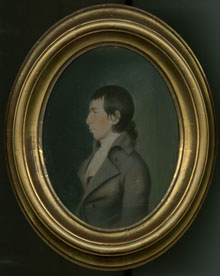
![C.B.B. [i.e., Charles Brockden Brown.] Advertisement. September 3, 1798. Prefatory to most copies of Wieland; or, The Transformation (New-York, 1798).](images/th2.2.jpg)
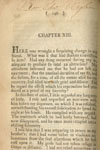
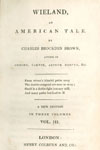
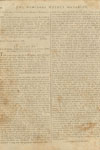
![John Marsh. The Great Sin and Danger of Striving With God. A Sermon preached at Wethersfield, December 13th, 1782. At the funeral of Mrs. Lydia Beadle, wife of the late William Beadle, and their four children, who were all murdered by his own hands on the morning of the 11th instant. (Hartford, [1783]).](images/th2.7.jpg)
![[Judge Stephen Mix Mitchell]. A Narrative of the Life of William Beadle, of Wethersfield. … The particulars of the “horrid massacre” of himself and family. (Hartford, [1783]).](images/th2.8.jpg)
